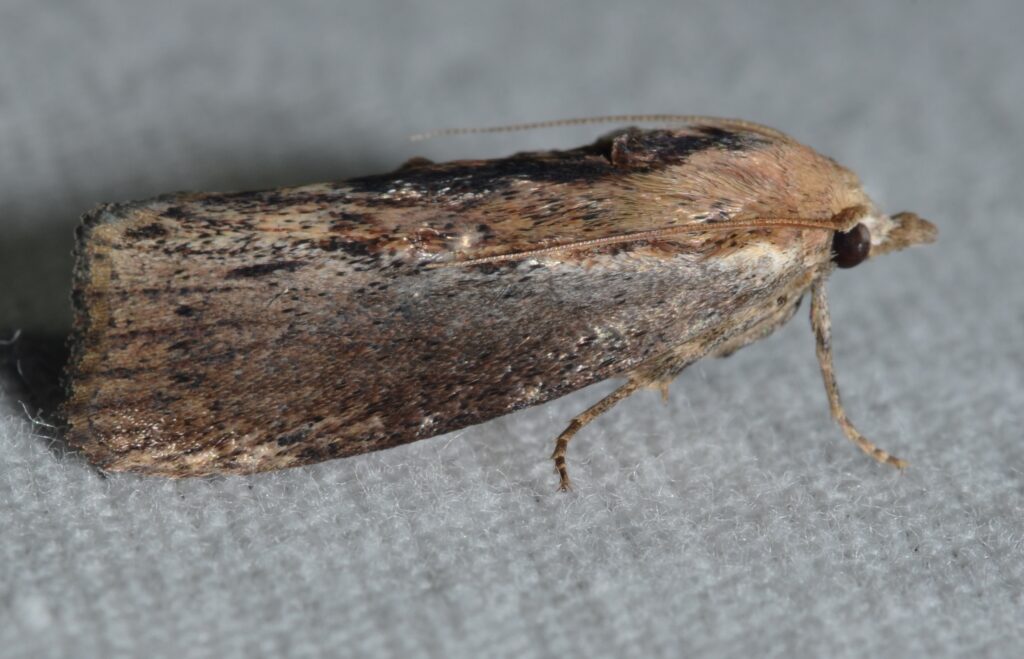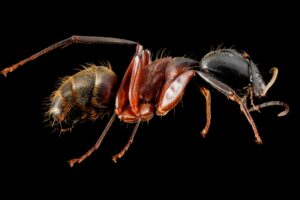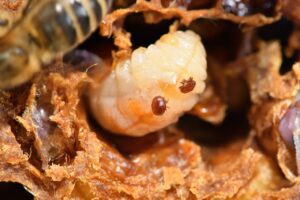Are honey bees endangered? The alarming decline in honey bee populations, exacerbated by factors like Varroa mites, has sparked urgent global conservation efforts. Understanding the critical role of honey bees in agriculture and their broader global impact is essential. This article explores the causes of population decline, the devastating impact of Varroa mites, and ongoing conservation efforts aimed at safeguarding these vital pollinators.

Table of Contents
1. Population Decline
Global Trends
Honey bee populations have been experiencing a significant decline across the globe which begs the question are honey bees endangered? This trend is particularly concerning as bees are crucial pollinators for many of the world’s crops. Over the past few decades, the decline has been reported in various regions, with some areas seeing losses of up to 50% of their honey bee colonies. This decline poses a serious threat to biodiversity and agricultural productivity.
- Regional Variations: The decline in honey bee populations varies by region, with some areas experiencing more severe losses than others.
- Long-term Trends: Research suggests that honey bee populations have been declining steadily since the mid-20th century, with recent years showing accelerated declines. Read Unveiling the Ancient History of Beekeeping: 4,500 Years of Beekeeping Traditions for a more comprehensive history.
- Impact on Wild Bees: The decline of honey bees can also impact wild bee species that rely on similar habitats and resources.
Causes
Several factors contribute to the decline in honey bee populations. Habitat loss due to urban development and agriculture reduces the availability of food and nesting sites for bees. Additionally, the widespread use of pesticides, particularly neonicotinoids, has been linked to bee deaths and colony collapses. Diseases and parasites, such as the Varroa destructor mite, further exacerbate the problem by weakening bee colonies and spreading infections. We wrote more about the 8 Common Beehive Pests and Effective Prevention Tips for Beekeepers.
- Neonicotinoid Use: These pesticides are systemic and can persist in plants, affecting bees even after the initial application.
- Monoculture Agriculture: Large-scale farming practices that rely heavily on single crop types can limit bee foraging opportunities and nutrition diversity.
- Climate Change: Shifts in climate patterns can disrupt bee habitats and affect the availability of flowering plants crucial for their survival.
Impact
The decline in honey bee populations has profound implications for ecosystems and agriculture. As primary pollinators, honey bees are essential for the reproduction of many flowering plants, including those that produce fruits, vegetables, and nuts. Without sufficient pollination, crop yields can drop significantly, affecting food supply and prices. Moreover, the loss of bees could disrupt natural ecosystems, leading to a decrease in plant diversity and the wildlife that depends on them.
- Economic Costs: The economic cost of reduced crop yields due to poor pollination can be substantial, impacting farmers, consumers, and global food security.
- Ecosystem Services: Beyond pollination, bees contribute to soil health and biodiversity by supporting diverse plant communities.
- Indirect Effects: Bee declines can also affect other species in the ecosystem, such as birds and mammals that rely on pollinated plants for food and shelter.
2. Importance to Agriculture
Pollination Services
Honey bees are vital for the pollination of a vast array of crops. They are responsible for pollinating approximately 75% of flowering plants worldwide, including many of the fruits, vegetables, and nuts that are staples in human diets. This service is crucial for the production of crops such as almonds, blueberries, apples, and cucumbers. Without honey bees, many of these crops would not reproduce effectively, leading to lower yields and higher costs for consumers.
- Crop Diversity: Honey bees play a key role in maintaining crop diversity by pollinating a wide range of plant species.
- Alternative Pollinators: While honey bees are the most widely used pollinators, efforts are underway to promote the use of native bees and other insects for pollination.
- Pollination Efficiency: Studies show that honey bees can significantly increase crop yields through efficient pollination practices compared to wind or self-pollination.
Food Security
The role of honey bees in pollination is directly linked to global food security. Their decline threatens the availability and affordability of many foods that depend on pollination. For instance, the almond industry, which relies heavily on honey bee pollination, could face severe losses without sufficient bee populations. Ensuring the health and sustainability of honey bee colonies is therefore critical for maintaining a stable and sufficient food supply for the growing global population.
- Geographic Variability: The impact of bee decline on food security varies by region, with some areas more reliant on pollination services than others.
- Nutritional Diversity: Pollination by bees contributes to the variety of fruits and vegetables available in diets, supporting balanced nutrition.
- Consumer Costs: Reduced pollination can lead to higher prices for pollinator-dependent foods, affecting household food budgets and consumer choices.
Economic Value
The economic value of honey bee pollination is immense. According to some estimates, the value of crops pollinated by bees is worth over $15 billion annually in the United States alone. This includes not only direct crop yields but also the economic benefits derived from biodiversity and ecosystem services. The decline in honey bee populations could lead to significant economic losses, affecting farmers, consumers, and the broader economy.
- Market Effects: Bee declines can impact market stability for agricultural commodities, influencing prices and availability.
- Supply Chain Resilience: Maintaining healthy bee populations supports resilient agricultural supply chains that can withstand environmental challenges.
- Long-term Investments: Investing in bee conservation can yield long-term economic benefits by safeguarding pollination services and agricultural productivity.
3. Varroa Mites

Introduction
Varroa destructor mites are one of the most serious threats to honey bee populations worldwide. These tiny parasites attach themselves to honey bees, weakening them and transmitting viruses that can decimate entire colonies. Since their introduction to the United States in the 1980s, Varroa mites have spread rapidly, causing significant declines in bee populations. Their ability to reproduce quickly and adapt to different environments makes them particularly challenging to manage.
- Mite Lifecycle: Understanding the lifecycle of Varroa mites is crucial for implementing effective control measures within bee colonies.
- Global Distribution: Varroa mites are found in almost every region where honey bees are present, highlighting their widespread impact on bee health.
- Species Adaptation: Different strains of Varroa mites have developed resistance to some treatment methods, necessitating ongoing research into new control strategies.
Health Effects
Varroa mites compromise the health of honey bees by weakening their immune systems and spreading pathogens. Infected bees are more susceptible to diseases such as deformed wing virus, which can lead to high mortality rates within colonies. The stress caused by mite infestations also affects the bees’ ability to forage, navigate, and reproduce, further reducing colony survival rates. Effective management of Varroa mites is essential for maintaining healthy bee populations.
- Disease Transmission: Varroa mites act as vectors for several viruses that can devastate entire bee colonies within a short period.
- Sublethal Effects: Even low levels of mite infestation can impact bee behavior and physiology, affecting colony productivity over time.
- Environmental Factors: External environmental conditions, such as temperature and humidity, can influence mite populations and their impact on bee health.
Management Strategies
Various strategies are being employed to control Varroa mite infestations. Integrated pest management (IPM) approaches include the use of chemical treatments, biological controls, and cultural practices to reduce mite populations. Beekeepers are also encouraged to monitor their hives regularly for signs of infestation and to implement practices such as drone brood removal, which can help reduce mite reproduction rates. Research into new treatments and resistant bee strains continues to be a vital area of focus for scientists and beekeepers alike.
- Chemical Treatments: Miticides are commonly used to control mite populations, but their efficacy can diminish over time due to resistance development.
- Biological Controls: Some beekeepers use predatory mites or fungi to target Varroa mites while minimizing chemical exposure to honey bees.
- Selective Breeding: Breeding honey bee colonies for resistance traits against Varroa mites is a long-term strategy to enhance colony health and productivity.
4. Conservation Efforts
Habitat Restoration
Restoring habitats is a key strategy in protecting honey bee populations. Efforts include planting wildflowers, establishing pollinator-friendly gardens, and preserving natural habitats that provide food and nesting sites for bees. Programs aimed at creating and maintaining bee-friendly landscapes are essential for supporting bee health and biodiversity. By restoring habitats, we can help ensure that honey bees have the resources they need to thrive.
- Urban Beekeeping: Supporting urban beekeeping initiatives can provide additional foraging opportunities for honey bees in urban landscapes.
- Native Plant Restoration: Planting native flowering plants can enhance habitat quality for bees while promoting local biodiversity.
- Community Engagement: Involving communities in habitat restoration projects raises awareness about bee conservation and fosters stewardship of natural resources.
Pesticide Reduction
Reducing the use of harmful pesticides is critical for protecting honey bees. Many pesticides, especially neonicotinoids, have been shown to be toxic to bees, affecting their navigation, reproduction, and survival. Regulations and guidelines are being implemented to limit pesticide use and promote safer alternatives. Additionally, advocacy and awareness campaigns are helping to reduce pesticide exposure and encourage the adoption of bee-friendly farming practices.
- Integrated Pest Management (IPM): IPM strategies prioritize non-chemical pest control methods, such as crop rotation and biological pest control agents, to minimize pesticide use.
- Policy Initiatives: Government regulations and industry standards play a crucial role in reducing pesticide impacts on pollinators through labeling requirements and restricted use periods.
- Educational Programs: Educating farmers and agricultural stakeholders about pesticide risks and alternative pest management practices supports sustainable agricultural practices that benefit bee health.
Education and Awareness
Education and awareness are crucial for honey bee conservation. Programs aimed at educating beekeepers, farmers, and the general public about the importance of bees and how to protect them are gaining traction. Workshops, community events, and online resources are helping to spread knowledge about best practices for bee conservation. By increasing awareness and fostering a sense of responsibility, we can inspire more people to take action to protect honey bees and their habitats.
- Youth Outreach: Engaging young people in bee conservation efforts through school programs and youth organizations cultivates a new generation of environmental stewards.
- Media Campaigns: Utilizing digital platforms and social media to raise awareness about bee conservation issues and mobilize public support for pollinator protection initiatives.
- Citizen Science: Involving citizen scientists in monitoring bee populations and habitat quality provides valuable data for research and conservation efforts.
5. Global Impact
Ecological Consequences
The decline of honey bee populations has significant ecological consequences. Bees are not only crucial for crop pollination but also play a key role in the reproduction of many wild plants. The loss of bees can lead to reduced plant diversity, affecting entire ecosystems. This decline can disrupt food chains, reduce habitat availability for other species, and decrease biodiversity, which is essential for ecosystem resilience and stability.
- Pollination Networks: Bees contribute to complex networks of plant-pollinator interactions that support ecosystem functioning and resilience to environmental changes.
- Keystone Species: As keystone species, bees influence the structure and function of ecosystems by facilitating the reproduction of diverse plant communities.
- Conservation Priorities: Protecting bee populations helps safeguard ecosystem services that benefit human well-being, including water purification and carbon sequestration.
Economic Implications
The economic impact of declining honey bee populations is profound. The value of crops dependent on bee pollination is substantial, and any reduction in bee numbers can lead to increased costs for farmers and consumers. In addition to direct economic losses in agriculture, the decline in bees can affect industries reliant on natural resources, such as forestry and horticulture. The broader economic implications highlight the need for urgent action to protect and restore honey bee populations.
- Supply Chain Vulnerabilities: Vulnerabilities in agricultural supply chains due to bee declines can affect global trade and food security.
- Insurance Policies: Some farmers invest in pollination insurance policies to mitigate financial risks associated with unpredictable bee populations.
- Alternative Pollinators: Exploring alternative pollination strategies, such as robotic pollinators or native bee species, may offer resilience against bee decline impacts.
International Collaboration
Addressing the decline in honey bee populations requires global cooperation. Countries, organizations, and researchers are increasingly working together to develop and implement strategies for bee conservation. International initiatives, research programs, and policy frameworks are being established to protect honey bees and their habitats. By fostering global collaboration, we can enhance conservation efforts and ensure a sustainable future for honey bees and the vital services they provide.
Additional Resources
12 Tips for Managing and Preventing Hive Beetles in Your Apiary

Understanding Wax Moths: 7 Key Facts Every Beekeeper Should Know

Conservation Reserve Program from the USDA
Conclusion
The plight of honey bees endangered due to population decline and the devastating effects of Varroa mites underscores the urgent need for robust conservation efforts. As we strive to protect these crucial pollinators, understanding their global impact on agriculture and ecosystems remains paramount. By supporting habitat restoration, reducing pesticide use, and promoting bee-friendly practices, we can work towards ensuring a sustainable future for honey bees and the invaluable services they provide.


